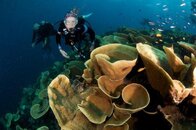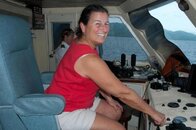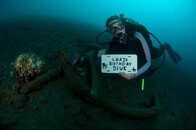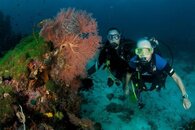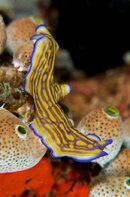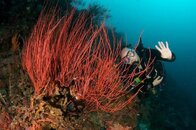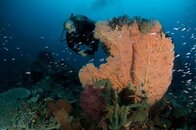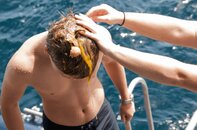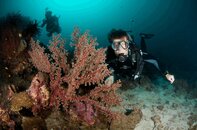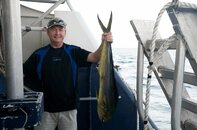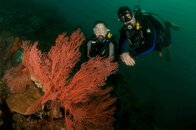- Messages
- 270
- Reaction score
- 6
Star Dancer Captain's Log Feb 28 - March 8, 2012
Feb 28th Time to take a deep breath of the ocean breeze as the Star Dancer parts the mirror like waters of Milne Bay. We have anxious guests from Germany, Russia and the USA. Our first ocean venture lasts for 4 hours and with perfect timing, dinner is served at sunset. The stars gaze down at the scarlet balled sun burning into the horizon leaving a brilliant water colored sky.
Feb 29th The weather is absolutely perfect. Patchy billowing clouds mask the vibrant blue backdrop of sky. The island of Gona Bala Bala is a lush green coconut tree filled landmass. Approaching the island is always exciting. Near shore, small black tips pierce the surface. As we come closer, the shape of the from where the tips are seen. Giants manta rays parallel the shore line on the surface as they feed in the marine rich waters. A quick briefing, we plunge in and shortly after our first sighting of this truly amazing beast. Our guests our dwarfed by the sheer mass of the mantas. With wing spans of 18 feet, the mantas come in and out of the range of the visibility. Leather soft coral blanket the bottom of the ocean with nudibranchs of all colors creep and crawl to the delight of our Russian nudibranch lover, Svetya. The second dive is even more exciting as we head to the coral formation that the mantas frequent to be cleaned. The whole dive the animals spend with the guests giving an underwater acrobatic show. Ryan, from the USA, is beaming with asmile and is happy that he could get pictures of his first manta sightings in his life. The afternoon dives are held at the crowd favorite, Samarai Wharf. Pulling up to the wharf, the water boils with life. Bait fish encircle the wharf’s pilings and that brings in the hunters. Trevally and small tuna loom in the deeper waters darting in the pilings in packs to feast on the numerous bait balls seeking shelter of the structure. Banded pipefish , lionfish, batfish keep to the wharf and add to the splendor of the dive. Our first night dive has some rere sightings. A pink cockatoo waspfish rocks back and forth with the surge of the ocean. Big batfish rest right underneath the boat in the moonlight as translucent moon jellies pass through a small school of squid.
View attachment 118339
Mar 1st Calm seas at night going to Nuakata Island, waking up to patch work of blue and white sewn together above and the ocean awaits our eager adventurous side. The morning sail to Little China signifies the start of our pinnacle dives. The international group of divers make a splash and are quickly treated to the tassled mouth of a Wobegone shark contouring the bottom of the coral filled sea mount. Divers delight in color and fins. Fish sweep over the reef in a mass of motion. Continuing in the frolicking at Linda’s reef, anthias by the thousands levitate above the hard coral structure in a wave of oranges and violets. A dormant white tip reef sharks lies inbetween the two coral formations on a sandy patch only to be woken up by the intrusive sounds of our bubble blowers.
Mar 2nd An early start to the day as we head to the far reaches of Milne Bay. The table top plateau stretches on the outskirts of two islands. Joe’s reef is nestled in the middle of a sloping soft coral wall filled with ornate and colorful sea fans. Coming into sight with a large coral breaking beak is a 4 foot long parrotfish. Green in color with a pink ridge running the length of it’s snout to the top of it’s bulbous head. The formidable fish makes it’s way through the coral patches biting bits of the firm coral mounts. Through time these fish actually been the main contributors to creating the beautiful white sand beaches around the world. Doubilet’s Reef is just off the corner of the main reef system. Booming with sea fans , Doubilet’s is an oasis in the middle of the ocean. Surgeon fish in large numbers concentrate themselves a few feet off the reef creating a cloud of fish that divers can be enveloped in. After the day of diving is complete we are treated to a night of stars and calm seas as we follow the stars to our Nuakata anchorage.
Mar 3rd Back at it again in the morning. The skies are clear and inviting the light down into the sea for crisp blue water filled with adventure. Pulling just off Nuakata’s half moon bay, Jason’s reef is a high rising sea mount. The bannerfish line the corner of the reef. The streamer off the top of their head flaps in the slow moving current. Ryan is able to snap a few shots of a passing hawksbill turtle. With the flash the shell backed amphibian turns shell towards our eager photographer and rapidly pickups it’s pace away to flee the aquatics paparazzi. Crinoid City tops off the day. A little bit of current brings a swarm of fish over the reef . Dancing coiled at 70 feet on a white sand bed, a colony of garden eels stand at attention. The question mark shaped eels dip down as the onlookers get closer.
View attachment 118340
Mar 4th Boirama is a treat to dive this week. Close to shore we have a perfect of the village life of Papua New Guinea. Canoes lie on the beach and are being filled with fresh tropical delight from the villagers gardens. Paddling out on the placid sea, the natives bring an assortment of organic cucumbers, papaya, eggplant, star fruit and coconuts to trade. The cornucopia of fruits and vegetables are traded for rice, noodles and biscuits off the back of Star Dancer. Now the dive, Dropping down into the depths the bending reef is filled with an array of colorful fish. One of the special dives of the charter is to make it out to Peer’s Reef and a spectacular wall experience. Current laden, Peer’s Reef boasts large fish and falling walls into the abyss. Enormous groupers wait in the corals heads as we follow the flow of current along the wall. A sand channel leads our way with coral heads protruding skyward. Two great dives to start the morning! Crossing over to Normanby Island, we begin our black sand dives at Bunama Village. Tiny treasures lie in the eel grass and under logs. A banded snake eel scurries through the grass poking it’s head into burrows made in the sand eventually wiggling free some distance away.
Mar 5th As the sun slowly rises to cast light on the blue waters. Dolphins break the surface as they head to the bow of the boat for an early morning surfing session. Plunging down, the dual mountainous towers are covered with sea fans and a patch of healthy cabbage coral. In the midst of the the yellow blossoming coral sits an anemone with two skunk anemone fish swishing their bodies in the tentacles of the bizarre sea creature. The waters are alive with fins. Trevally, Titan triggerfish and several other fish circle over the coral running in and out of the fish masses. Dropping Following the face of the pinnacle downward, the pinnacle levels out to a platform of coral transversing the gap between the two aquatic towers. The green acropra hard coral sprouts out in a lattice of life where golden anthias huddle close to one another packing a contrast of dark green coral and golden flashes of fish. Keeping with the hard coral scenery, a short run over to Calypso. Jacque Cousteau named the reef after his vessel when filming a documentary on Papua New Guinea. The hard coral studded wall plays host to butterfly fish, parrotfish and every tropical fish that one can image. The hard coral fills the land and the fish cloud the water. Amongst the fish, a curious hawksbill turtle is startled as it rapidly vanishes over the wall. Laying soundly on the reef a white tip shark is awakened by the sound of approaching bubbles. Veering off the reef, the toothy denizen banks a hard left to parallel the reef the dives deep to avoid further encounters.
View attachment 118341
Mar 6th Passing by the East Cape of Milne Bay, we head to the northern coast in hopes of big animal sightings. Wahoo point has been a location where the deep waters and sheer drop offs are perfect for pelagic to roam freely close to divers. A slight current is perfect for such animals and right off the wall a giant manta ray follows behind divers only to quickly catch up to the bubble makers and pass by within a few feet. Our Russian and German friends are delighted at yet another experience with a majestic creature. Slowly passing by, the solitary silhouette vanishes out of sight. We have time to catch a bite to eat and back in the water for an afternoon at Laudi and Deacon Reef. Hailed as one of the great dive sites in all of Papua New Guinea, we have a combination of brilliant reef structure feeding into a sand bank sloping into the abyss. If you are good on your air consumption then both of the sites will be available. It’s a perfect of what Milne Bay has to offer. Gorgeous coral reefs with azure blue back drops and a sand bank loaded with tiny creatures that only the sharp eye of our dive staff can find. We find several clownfish making homes in radiant green and purple anenomes and rustic brown and black seahorses clinging to twigs of fallen trees.
Mar 7th Deacon’s and Laudi were such a crowd favorite that we decided to stay the night in the glassy calm water of Laudi. The jungle breeze flows down the lush jungle coming to the shore. Hornbill and Cockatoos fly above for tree to tree. Octopi and lionfish liter the reef. Bannerfish sit on the sloping sand and bait fish come in from the deep waters to look for food. Cobb’s Cliff ends our full day of diving and the current brings in the wildlife. Batfish block out the sun as well as a Napoleon Wrasse teasing us with close passes.
Mar 8th Tania’s reef is beautiful. Baitfish run the sloping wall with fusiliers and surgeon fish gulping at feed the passes by in the current. A good 10 days of diving. Thank you to all of our international guests that made their way over to visit us on the Star Dancer in Milne Bay.
For The Ocean,
Captain Lowel
Feb 28th Time to take a deep breath of the ocean breeze as the Star Dancer parts the mirror like waters of Milne Bay. We have anxious guests from Germany, Russia and the USA. Our first ocean venture lasts for 4 hours and with perfect timing, dinner is served at sunset. The stars gaze down at the scarlet balled sun burning into the horizon leaving a brilliant water colored sky.
Feb 29th The weather is absolutely perfect. Patchy billowing clouds mask the vibrant blue backdrop of sky. The island of Gona Bala Bala is a lush green coconut tree filled landmass. Approaching the island is always exciting. Near shore, small black tips pierce the surface. As we come closer, the shape of the from where the tips are seen. Giants manta rays parallel the shore line on the surface as they feed in the marine rich waters. A quick briefing, we plunge in and shortly after our first sighting of this truly amazing beast. Our guests our dwarfed by the sheer mass of the mantas. With wing spans of 18 feet, the mantas come in and out of the range of the visibility. Leather soft coral blanket the bottom of the ocean with nudibranchs of all colors creep and crawl to the delight of our Russian nudibranch lover, Svetya. The second dive is even more exciting as we head to the coral formation that the mantas frequent to be cleaned. The whole dive the animals spend with the guests giving an underwater acrobatic show. Ryan, from the USA, is beaming with asmile and is happy that he could get pictures of his first manta sightings in his life. The afternoon dives are held at the crowd favorite, Samarai Wharf. Pulling up to the wharf, the water boils with life. Bait fish encircle the wharf’s pilings and that brings in the hunters. Trevally and small tuna loom in the deeper waters darting in the pilings in packs to feast on the numerous bait balls seeking shelter of the structure. Banded pipefish , lionfish, batfish keep to the wharf and add to the splendor of the dive. Our first night dive has some rere sightings. A pink cockatoo waspfish rocks back and forth with the surge of the ocean. Big batfish rest right underneath the boat in the moonlight as translucent moon jellies pass through a small school of squid.
View attachment 118339
Mar 1st Calm seas at night going to Nuakata Island, waking up to patch work of blue and white sewn together above and the ocean awaits our eager adventurous side. The morning sail to Little China signifies the start of our pinnacle dives. The international group of divers make a splash and are quickly treated to the tassled mouth of a Wobegone shark contouring the bottom of the coral filled sea mount. Divers delight in color and fins. Fish sweep over the reef in a mass of motion. Continuing in the frolicking at Linda’s reef, anthias by the thousands levitate above the hard coral structure in a wave of oranges and violets. A dormant white tip reef sharks lies inbetween the two coral formations on a sandy patch only to be woken up by the intrusive sounds of our bubble blowers.
Mar 2nd An early start to the day as we head to the far reaches of Milne Bay. The table top plateau stretches on the outskirts of two islands. Joe’s reef is nestled in the middle of a sloping soft coral wall filled with ornate and colorful sea fans. Coming into sight with a large coral breaking beak is a 4 foot long parrotfish. Green in color with a pink ridge running the length of it’s snout to the top of it’s bulbous head. The formidable fish makes it’s way through the coral patches biting bits of the firm coral mounts. Through time these fish actually been the main contributors to creating the beautiful white sand beaches around the world. Doubilet’s Reef is just off the corner of the main reef system. Booming with sea fans , Doubilet’s is an oasis in the middle of the ocean. Surgeon fish in large numbers concentrate themselves a few feet off the reef creating a cloud of fish that divers can be enveloped in. After the day of diving is complete we are treated to a night of stars and calm seas as we follow the stars to our Nuakata anchorage.
Mar 3rd Back at it again in the morning. The skies are clear and inviting the light down into the sea for crisp blue water filled with adventure. Pulling just off Nuakata’s half moon bay, Jason’s reef is a high rising sea mount. The bannerfish line the corner of the reef. The streamer off the top of their head flaps in the slow moving current. Ryan is able to snap a few shots of a passing hawksbill turtle. With the flash the shell backed amphibian turns shell towards our eager photographer and rapidly pickups it’s pace away to flee the aquatics paparazzi. Crinoid City tops off the day. A little bit of current brings a swarm of fish over the reef . Dancing coiled at 70 feet on a white sand bed, a colony of garden eels stand at attention. The question mark shaped eels dip down as the onlookers get closer.
View attachment 118340
Mar 4th Boirama is a treat to dive this week. Close to shore we have a perfect of the village life of Papua New Guinea. Canoes lie on the beach and are being filled with fresh tropical delight from the villagers gardens. Paddling out on the placid sea, the natives bring an assortment of organic cucumbers, papaya, eggplant, star fruit and coconuts to trade. The cornucopia of fruits and vegetables are traded for rice, noodles and biscuits off the back of Star Dancer. Now the dive, Dropping down into the depths the bending reef is filled with an array of colorful fish. One of the special dives of the charter is to make it out to Peer’s Reef and a spectacular wall experience. Current laden, Peer’s Reef boasts large fish and falling walls into the abyss. Enormous groupers wait in the corals heads as we follow the flow of current along the wall. A sand channel leads our way with coral heads protruding skyward. Two great dives to start the morning! Crossing over to Normanby Island, we begin our black sand dives at Bunama Village. Tiny treasures lie in the eel grass and under logs. A banded snake eel scurries through the grass poking it’s head into burrows made in the sand eventually wiggling free some distance away.
Mar 5th As the sun slowly rises to cast light on the blue waters. Dolphins break the surface as they head to the bow of the boat for an early morning surfing session. Plunging down, the dual mountainous towers are covered with sea fans and a patch of healthy cabbage coral. In the midst of the the yellow blossoming coral sits an anemone with two skunk anemone fish swishing their bodies in the tentacles of the bizarre sea creature. The waters are alive with fins. Trevally, Titan triggerfish and several other fish circle over the coral running in and out of the fish masses. Dropping Following the face of the pinnacle downward, the pinnacle levels out to a platform of coral transversing the gap between the two aquatic towers. The green acropra hard coral sprouts out in a lattice of life where golden anthias huddle close to one another packing a contrast of dark green coral and golden flashes of fish. Keeping with the hard coral scenery, a short run over to Calypso. Jacque Cousteau named the reef after his vessel when filming a documentary on Papua New Guinea. The hard coral studded wall plays host to butterfly fish, parrotfish and every tropical fish that one can image. The hard coral fills the land and the fish cloud the water. Amongst the fish, a curious hawksbill turtle is startled as it rapidly vanishes over the wall. Laying soundly on the reef a white tip shark is awakened by the sound of approaching bubbles. Veering off the reef, the toothy denizen banks a hard left to parallel the reef the dives deep to avoid further encounters.
View attachment 118341
Mar 6th Passing by the East Cape of Milne Bay, we head to the northern coast in hopes of big animal sightings. Wahoo point has been a location where the deep waters and sheer drop offs are perfect for pelagic to roam freely close to divers. A slight current is perfect for such animals and right off the wall a giant manta ray follows behind divers only to quickly catch up to the bubble makers and pass by within a few feet. Our Russian and German friends are delighted at yet another experience with a majestic creature. Slowly passing by, the solitary silhouette vanishes out of sight. We have time to catch a bite to eat and back in the water for an afternoon at Laudi and Deacon Reef. Hailed as one of the great dive sites in all of Papua New Guinea, we have a combination of brilliant reef structure feeding into a sand bank sloping into the abyss. If you are good on your air consumption then both of the sites will be available. It’s a perfect of what Milne Bay has to offer. Gorgeous coral reefs with azure blue back drops and a sand bank loaded with tiny creatures that only the sharp eye of our dive staff can find. We find several clownfish making homes in radiant green and purple anenomes and rustic brown and black seahorses clinging to twigs of fallen trees.
Mar 7th Deacon’s and Laudi were such a crowd favorite that we decided to stay the night in the glassy calm water of Laudi. The jungle breeze flows down the lush jungle coming to the shore. Hornbill and Cockatoos fly above for tree to tree. Octopi and lionfish liter the reef. Bannerfish sit on the sloping sand and bait fish come in from the deep waters to look for food. Cobb’s Cliff ends our full day of diving and the current brings in the wildlife. Batfish block out the sun as well as a Napoleon Wrasse teasing us with close passes.
Mar 8th Tania’s reef is beautiful. Baitfish run the sloping wall with fusiliers and surgeon fish gulping at feed the passes by in the current. A good 10 days of diving. Thank you to all of our international guests that made their way over to visit us on the Star Dancer in Milne Bay.
For The Ocean,
Captain Lowel



